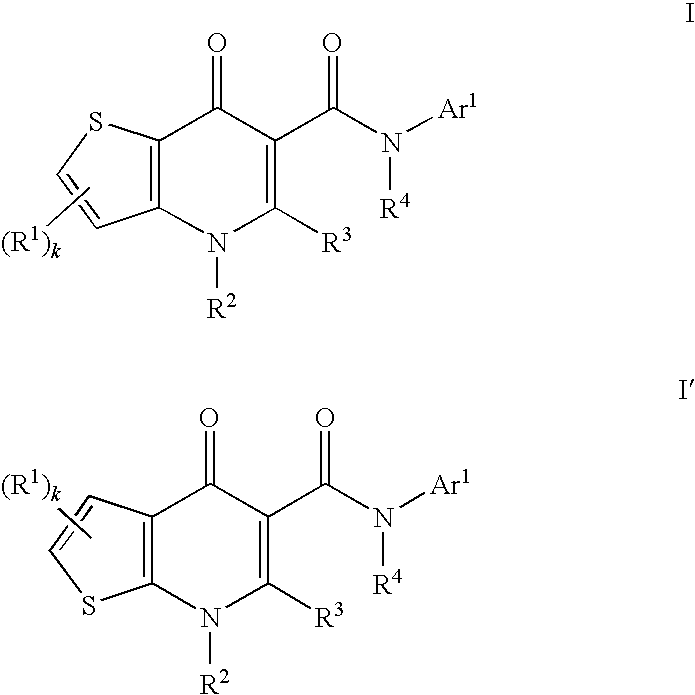Modulators of cystic fibrosis transmembrane conductance regulator
a technology of transmembrane conductance and cystic fibrosis, which is applied in the field of modulators of cystic fibrosis transmembrane conductance regulators, can solve the problems of imbalance in ion and fluid transport, debilitating and fatal effects of cf, and reducing anion transport, so as to reduce the severity
- Summary
- Abstract
- Description
- Claims
- Application Information
AI Technical Summary
Benefits of technology
Problems solved by technology
Method used
Image
Examples
examples
[0243]General Scheme
[0244]
Example
[0245]
[0246]Diethyl 2-((thiophen-3-ylamino)methylene)malonate 2: A mixture of methyl 3-aminothiophene-2-carboxylate 1 (5.0 g, 32 mmol, 1.0 eq), N-methyl piperazine (6.5 g, 64 mmol, 2.0 eq) and NMP (30 mL) was heated to reflux for 16 hours. After the decarboxylation was complete, the reaction mixture was allowed to cool to room temperature and diethyl 2-(ethoxymethylene)-malonate (7.0 g, 32 mmol, 2.0 eq) was added. The reaction mixture was heated to reflux for 4 h. The product was purified using SiO2 column chromatography (Hex / EtOAc; 100:0 to 80:20%) to obtain a light yellow powder, 5.0 g (31%). LC / MS (10-99% CH3CN / 0.05% TFA gradient over 5 min): m / z 270.2, retention time 1.52 minutes. 1H NMR (DMSO-d6) δ: 10.80 (d, 1.0 H, J=13.87 Hz, NH), 8.30 (d, 1.0 H, J=13.94 Hz), 7.60 (dd, 1.0H, J=3.0 Hz, J′=2.0 Hz), 7.40 (dd, 1.0 H, J=1.5 Hz, J′=3.13 Hz), 7.28 (dd, 1.0 H, J=1.5 Hz, J′=5.2 Hz), 4.20 (q, 2H, J=7.0 Hz), 4.10 (q, 2H, J=7.0 Hz), 1.30 (m, 6H).
[0247]Eth...
example
[0259]
2-Bromo-4-tert-butyl-phenylamine
[0260]To a solution of 4-tert-butyl-phenylamine (447 g, 3 mol) in DMF (500 mL) was added dropwise NBS (531 g, 3 mol) in DMF (500 mL) at room temperature. Upon completion, the reaction mixture was diluted with water and extracted with EtOAc. The organic layer was washed with water, brine, dried over Na2SO4 and concentrated. The crude product was directly used in the next step without further purification.
2-Bromo-4-tert-butyl-5-nitro-phenylamine
[0261]2-Bromo-4-tert-butyl-phenylamine (162 g, 0.71 mol) was added dropwise to H2SO4 (410 mL) at room temperature to yield a clear solution. This clear solution was then cooled down to −5 to −10° C. A solution of KNO3 (82.5 g, 0.82 mol) in H2SO4 (410 mL) was added dropwise while the temperature was maintained between −5 to −10° C. Upon completion, the reaction mixture was poured into ice / water and extracted with EtOAc. The combined organic layers were washed with 5% Na2CO3 and brine, dried over Na2SO4 and c...
example 4
[0265]General scheme
[0266]
[0267]Specific example
[0268]
2-tert-Butyl-4-fluorophenol
[0269]4-Fluorophenol (5 g, 45 mmol) and tent-butanol (5.9 mL, 63 mmol) were dissolved in CH2Cl2 (80 mL) and treated with concentrated sulfuric acid (98%, 3 mL). The mixture was stirred at room temperature overnight. The organic layer was washed with water, neutralized with NaHCO3, dried over MgSO4 and concentrated. The residue was purified by column chromatography (5-15% EtOAc-Hexane) to give 2-tert-butyl-4-fluorophenol (3.12 g, 42%). 1H NMR (400 MHz, DMSO-d6) δ 9.32 (s, 1H), 6.89 (dd, J=11.1, 3.1 Hz, 1H), 6.84-6.79 (m, 1H), 6.74 (dd, J=8.7, 5.3 Hz, 1H), 1.33 (s, 9H).
2-tert-Butyl-4-fluorophenyl methyl carbonate
[0270]To a solution of 2-tert-butyl-4-fluorophenol (2.63 g, 15.7 mmol) and NEt3 (3.13 mL, 22.5 mmol) in dioxane (45 mL) was added methyl chloroformate (1.27 mL, 16.5 mmol). The mixture was stirred at room temperature for 1 h. The precipitate was removed via filtration. The filtrate was then dilute...
PUM
| Property | Measurement | Unit |
|---|---|---|
| temperature | aaaaa | aaaaa |
| temperature | aaaaa | aaaaa |
| temperature | aaaaa | aaaaa |
Abstract
Description
Claims
Application Information
 Login to View More
Login to View More - R&D
- Intellectual Property
- Life Sciences
- Materials
- Tech Scout
- Unparalleled Data Quality
- Higher Quality Content
- 60% Fewer Hallucinations
Browse by: Latest US Patents, China's latest patents, Technical Efficacy Thesaurus, Application Domain, Technology Topic, Popular Technical Reports.
© 2025 PatSnap. All rights reserved.Legal|Privacy policy|Modern Slavery Act Transparency Statement|Sitemap|About US| Contact US: help@patsnap.com



